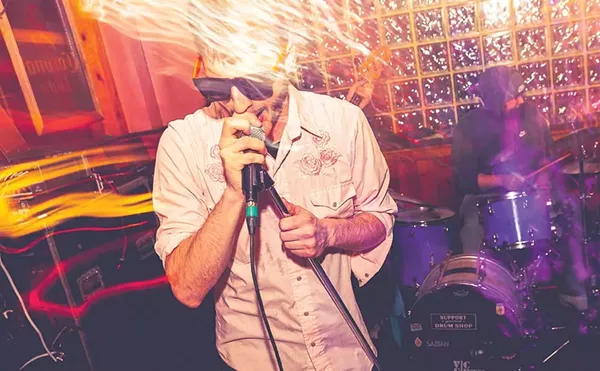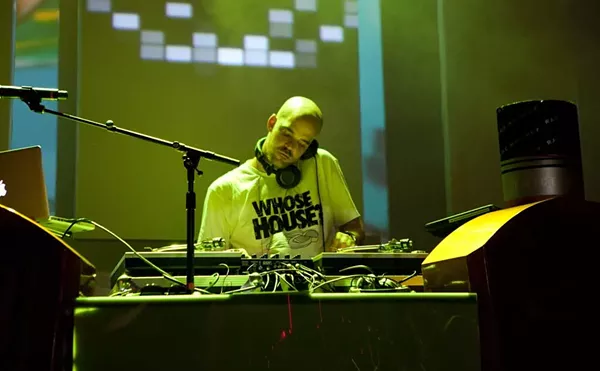High School: There is no more magical time than these four years, when lifelong musical tastes and styles are formed, when young minds are open to exchanging ideas, and when, if the conditions are right, rebellious energy, unwitting originality and youthful drive combine with teenage drama and emerge as scene-making music.
Fueled by the jazz, country and R&B that simmered before it, rock 'n' roll's big bang was nowhere more evident than in the high schools of metro Detroit. Between 1955 and 1970, the sheer number of young Detroiters who shook up the music world — many of whom were still in school when they did so — is almost too large to reckon with. In no way complete, what follows is a brief survey of the foundations of Motor City rock 'n' roll viewed through the prism of the schools where so many young dreamers strummed or sang the initial notes of what would become a well-known thread of the American musical landscape.
By nearly every account, it all started with Nolan Strong and the Diablos, who harmonized in the hallways of Central High across the street from Fortune Records' fledgling first studio on Linwood.
One day, the group stopped by to make a demo and, though Fortune's owners knew nothing about R&B, they loved Nolan's ethereally high tenor. The Diablos' first hit, 1954's "The Wind," was eerie and dreamlike, invading the teenage consciousness of Northern High's Smokey Robinson, who still counts Strong as one of his biggest influences. Becoming synonymous with vocal group R&B, Fortune's open-door policy became legendary by the time they moved over to Third Avenue in 1956: High school kids were recruited right off the street to sing and play on sessions, giving many of their records an unpredictable, party-like atmosphere.
Northeastern and Northwestern had already been breeding similar talents in the Serenaders and Blue Notes, respectively. Both groups practiced in the back of Joe Von Battle's Record Shop, and the Blue Notes — featuring guitarist Johnnie Bassett and pianist Joe Weaver — were secretly recorded by Von Battle for Deluxe before following in the Diablos' footsteps to Fortune and becoming one of their early house bands. The Serenaders would make the trek to Fortune as well, but not before a name change to the Royal Jokers and a 1956 hit on Atco ("You Tickle Me Baby") that turned them into one of the best-known — and most idolized — groups in Detroit.
Dearborn's racist administration, led by Mayor Orville Hubbard, may have ensured its high schools were 100 percent white, but there was no controlling the musical tastes of the teenage citizenry. Paralleling Edsel Ford High's first graduating class in 1956 were the Larados, whose greasy harmonies had grown out of a Diablos fan club called the Diablo Dukes and were memorably etched into wax on 1957's "Bad Bad Guitar Man" as well as Danny Zella's killer doo-wop ballad "You Made Me Blue." Rival Fordson High was home to the Royaltones, whose "Poor Boy" became a national hit in 1958, the summer saxophonist George Katsakis — who had played on the Jack Scott chart-topping hits "My True Love" and "Leroy" earlier that year — graduated.
"The Royaltones were the best band in Detroit," says guitarist Bruce Stratton, who, suitably inspired, formed the Flamethrowers at Royal Oak's Kimball High and named their first record, "Knight's Caper," after the Kimball Knights. Hard-edged instrumental combos were becoming a Detroit specialty, and groups like the Thunder Rocks and the Egyptians patented an overdriven blast whose intensity could have only come from the Motor City. When paired with soul singer Gino Washington, Inkster's Jeff and the Atlantics took the roar a decibel higher on hits like "Gino Is a Coward" and "Out of This World." It wouldn't be long before Hamtramck High's Mitch Ryder would run the sound up the national charts.
Not to be outdone, guitarists VC L. Veasey and Charles Wolfe began playing sessions while attending southwest Detroit's Western High School, laying down the unstoppable groove behind Nathaniel Mayer on "I Had a Dream" in 1964. They were soon touring as members of Edwin Starr's Soul Agents and went on to form psychedelic blues band Black Merda.
Inspired by the British Invasion as well as the fervent local scene (particularly the success of the aforementioned Ryder), high school garage bands like the Underdogs, the Keggs, the Illusions, the Beaubians, the Ruins and the Pleasure Seekers were coursing out of schools across the city by the mid-'60s. Royal Oak's Glenn Frey cut his teeth in the Subterraneans and the Mushrooms while attending Dondero High, while Ann Arbor's Pioneer High counted among its students Bob Seger, future producer-manager Jeep Holland, the Rationals' Scott Morgan and James Osterberg — soon to become Iggy Pop — who pounded the drums in the Iguanas.
When 3,000 kids showed up at the Southfield High School gym to see the Who, the Amboy Dukes and the Unrelated Segments play a concert sponsored by the school's 10-watt radio station in 1967, the Motor City's high school rock 'n' roll pedigree was etched in stone.
In the end, Lincoln Park High alumni the MC5 said it best in 1970's "High School":
They only wanna shake it up, baby,
Dance to the rockin' bands.
They only want a little excitement.
They like to get a little outta hand.
The song harked back to the pre-revolution teenage world from which they'd sprung and stood as a high-velocity salute to every kid who'd ever dreamed of trading the classroom for a recording studio. In Detroit, more often than not, they did.






